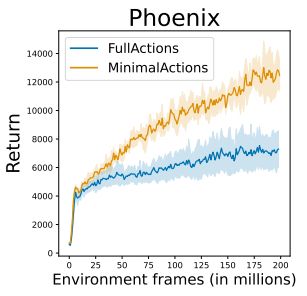
https://psc-g.github.io/
arxiv.org/abs/2510.16175
(I'll make a blog post soon, my webpage is quite out of date...)
18/X

arxiv.org/abs/2510.16175
(I'll make a blog post soon, my webpage is quite out of date...)
18/X
Advancing RL science in this manner could lead to the next big breakthrough...
17/X
Advancing RL science in this manner could lead to the next big breakthrough...
17/X
16/X
16/X
I refute that success of LLMs rests on decades of academic research not premised on this application.
15/X
I refute that success of LLMs rests on decades of academic research not premised on this application.
15/X
I argue they should be:
🔵 well-understood
🔵 diverse & without experimenter-bias
🔵 naturally extendable
Under this lens, the ALE is still a useful benchmark for RL research, *when used properly* (i.e. to advance science, rather than "winning").
14/X

I argue they should be:
🔵 well-understood
🔵 diverse & without experimenter-bias
🔵 naturally extendable
Under this lens, the ALE is still a useful benchmark for RL research, *when used properly* (i.e. to advance science, rather than "winning").
14/X
When reporting aggregate performance (like IQM), the choice of games subset can have a huge impact on algo comparisons (see figure below)!
We're missing the trees for the forest!🌳
🛑Stop focusing on aggregate results, & opt for per-game analyses!🛑
13/X


When reporting aggregate performance (like IQM), the choice of games subset can have a huge impact on algo comparisons (see figure below)!
We're missing the trees for the forest!🌳
🛑Stop focusing on aggregate results, & opt for per-game analyses!🛑
13/X
When ALE was introduced, Bellemare et al. recommended using 5 games for hparam tuning, & a separate set of games for eval.
This practice is no longer common, and people often use the same set of games for train/eval.
If possible, make them disjoint!
12/X

When ALE was introduced, Bellemare et al. recommended using 5 games for hparam tuning, & a separate set of games for eval.
This practice is no longer common, and people often use the same set of games for train/eval.
If possible, make them disjoint!
12/X
While 200M env frames was the standard set by Mnih et al, now there's a wide variety of lengths used (100k, 500k, 10M, 40M, etc.). In arxiv.org/abs/2406.17523 we showed exp length can have a huge impact on conclusions drawn (see first image).
11/X


While 200M env frames was the standard set by Mnih et al, now there's a wide variety of lengths used (100k, 500k, 10M, 40M, etc.). In arxiv.org/abs/2406.17523 we showed exp length can have a huge impact on conclusions drawn (see first image).
11/X
ɣ is central to training RL agents, but on the ALE we report undiscounted returns:
👉🏾We're evaluating algo's using a different objective than what they were trained for!👈🏾
To avoid ambiguity, we should report {ɣ_train} and ɣ_eval.
10/X

ɣ is central to training RL agents, but on the ALE we report undiscounted returns:
👉🏾We're evaluating algo's using a different objective than what they were trained for!👈🏾
To avoid ambiguity, we should report {ɣ_train} and ɣ_eval.
10/X
We'll use the ALE as an illustrative example.
tl;dr: be more explicit about evaluation process!
9/X
We'll use the ALE as an illustrative example.
tl;dr: be more explicit about evaluation process!
9/X
Given that we're dealing with a POMDP, state transitions are between Atari RAM states, & observations are affected by all the software wrappers.
Design decisions like whether end-of-life means end-of-episode affects transition dynamics & performance!
8/X

Given that we're dealing with a POMDP, state transitions are between Atari RAM states, & observations are affected by all the software wrappers.
Design decisions like whether end-of-life means end-of-episode affects transition dynamics & performance!
8/X
Since reward magnitudes vary a lot across games, Mnih et al. (2015) clipped rewards at [-1, 1] to be able to have global hparams. This can result in aliased rewards, which increases the partial observability of the system!
7/X
Since reward magnitudes vary a lot across games, Mnih et al. (2015) clipped rewards at [-1, 1] to be able to have global hparams. This can result in aliased rewards, which increases the partial observability of the system!
7/X
Since Atari games are deterministic, Mnih et al. (2015) added a series of no-op actions for non-determinancy. This is more interesting, but does move away from the original Atari games, thus part of the formalism-implementation gap.
6/X
Since Atari games are deterministic, Mnih et al. (2015) added a series of no-op actions for non-determinancy. This is more interesting, but does move away from the original Atari games, thus part of the formalism-implementation gap.
6/X
In the ALE you can use a "minimal set" or the full set, & you see both being used in the literature.
This choice matters a ton, but you don't always see it stated explicitly!
5/X

In the ALE you can use a "minimal set" or the full set, & you see both being used in the literature.
This choice matters a ton, but you don't always see it stated explicitly!
5/X
Nope, single Atari frames are not Markovian => for Markovian policies, design choices like frame skipping/stacking & max-pooling were taken.
*This means we're dealing with a POMDP!*
And these choices matter a ton (see image below)!
4/X

Nope, single Atari frames are not Markovian => for Markovian policies, design choices like frame skipping/stacking & max-pooling were taken.
*This means we're dealing with a POMDP!*
And these choices matter a ton (see image below)!
4/X
Stella is the emulator of the Atari 2600, but we use the ALE as a wrapper around it, which comes with its own design decisions.
But typically we interact with something like Gymnasium/CleanRL on top of that.
3/X

Stella is the emulator of the Atari 2600, but we use the ALE as a wrapper around it, which comes with its own design decisions.
But typically we interact with something like Gymnasium/CleanRL on top of that.
3/X
However, we almost never *explicitly* map our MDP formalism to the envs we evaluate on! This creates a *formalism-implementation gap*!
2/X


However, we almost never *explicitly* map our MDP formalism to the envs we evaluate on! This creates a *formalism-implementation gap*!
2/X
Read the paper at arxiv.org/abs/2510.13704
11/X

Read the paper at arxiv.org/abs/2510.13704
11/X
Try integrating SEMs and let us know what you find!
10/X
Try integrating SEMs and let us know what you find!
10/X
We evaluated Flow Q-Learning in offline-to-online to online training as well as FastTD3 on multitask settings, and observe gains throughout.
9/X

We evaluated Flow Q-Learning in offline-to-online to online training as well as FastTD3 on multitask settings, and observe gains throughout.
9/X
No!
We evaluate on FastTD3-SimBaV2 and FastSAC on HumanoidBench, FastTD3 on Booster T1, as well as PPO on Atari-10 and IsaacGym and observe gains in all these settings.
8/X

No!
We evaluate on FastTD3-SimBaV2 and FastSAC on HumanoidBench, FastTD3 on Booster T1, as well as PPO on Atari-10 and IsaacGym and observe gains in all these settings.
8/X

